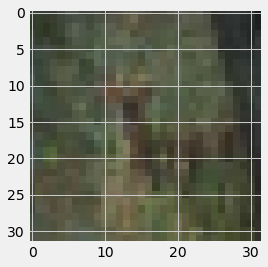- 投稿日:2020-05-28T21:28:49+09:00
【1日1写経】Classify_images_Using_Python & Machine Learning【Daily_Coding_003】
初めに
- 本記事は、python・機械学習等々を独学している小生の備忘録的な記事になります。
- 「自身が気になったコードを写経しながら勉強していく」という、きわめてシンプルなものになります。
- 建設的なコメントを頂けますと幸いです(気に入ったらLGTM & ストックしてください)。
お題:Classify_images_Using_Python & Machine Learning
今日のお題は、Classify_images_Using_Python & Machine LearningというYoutube上の動画です。犬やら猫らの画像を学習させてそれを判定する、といったものです。
Classify Images Using Python & Machine Learning
分析はyoutubeの動画にある通り、Google Colaboratryを使用しました。
それではやっていきたいと思います。
Step1: ライブラリのインポート~データの加工
import tensorflow as tf from tensorflow import keras from keras.models import Sequential from keras.layers import Dense, Flatten, Conv2D, MaxPool2D, Dropout from tensorflow.keras import layers from keras.utils import to_categorical import numpy as np import matplotlib.pyplot as plt plt.style.use('fivethirtyeight')次に
- データの読み込み
- データ型の確認
- データシェイプ確認
- いくつかのデータを確認
- 画像を一つ出力
までをやっていきます。
#1 from keras.datasets import cifar10 (x_train, x_test), (y_train, y_test) = cifar10.load_data() #2 print(type(x_train)) print(type(y_train)) print(type(x_test)) print(type(y_test)) #3 print('x_train shape:', x_train.shape) print('y_train shape:', y_train.shape) print('x_test shape:', x_test.shape) print('y_test shape:', y_test.shape) #4 index = 10 x_train[index] #5 img = plt.imshow(x_train[index])何やら画像が見えてきました。次にこの画像に紐づいているラベルを見ていきます。
print('The image label is:', x_train[index])これを見ると
4というラベルがついていることがわかります。次に開設されてますが、このデータセットは10種類の画像が含まれています。# Get the image classification classification = ['airplane', 'automobile', 'bird', 'cat', 'deer', 'dog', 'frog', 'horse', 'ship', 'truck'] # Print the image class print('The image class is:', classification[y_train[index][0]])なので、これは「鹿」の画像だそうです(よく画面にめっちゃ寄っても厳しい...)。
次に被説明変数yを
one_hot_encodingで、画像ラベルをNeural Networkに入れられる形に0 or 1(正しければ1、そうでなければ0)の数字を当てます。y_train_one_hot = to_categorical(y_train) y_test_one_hot = to_categorical(y_test) print(y_train_one_hot) print('The one hot label is:', y_train_one_hot[index])次にデータセットを標準化(0 - 1)にします。
x_train = x_train / 255 x_test = x_test / 255 x_train[index]これで凡そ加工はおしまいです。次にCNNモデルを組んでいきましょう!
Step2: モデルを構築
model = Sequential() model.add( Conv2D(32, (5,5), activation='relu', input_shape=(32,32,3))) model.add(MaxPool2D(pool_size=(2,2))) model.add( Conv2D(32, (5,5), activation='relu')) model.add(MaxPool2D(pool_size=(2,2))) model.add(Flatten()) model.add(Dense(1000, activation='relu')) model.add(Dropout(0.5)) model.add(Dense(500, activation='relu')) model.add(Dropout(0.5)) model.add(Dense(250, activation='relu')) model.add(Dense(10, activation='softmax'))次にモデルをコンパイルし、学習させていきます。
model.compile(loss= 'categorical_crossentropy', optimizer= 'adam', metrics= ['accuracy']) hist = model.fit(x_train, y_train_one_hot, batch_size = 256, epochs = 10, validation_split = 0.2)出来上がったmodelをtestデータでテストします。
model.evaluate(x_test, y_test_one_hot)[1] >> 0.6811000108718872うーん、動画でもそうでしたがあまり良い結果ではないですね。。。
とりあえずmatplotlibで精度と損失誤差を描画しておきます。
# Visualize the model accuracy plt.plot(hist.history['accuracy']) plt.plot(hist.history['val_accuracy']) plt.title('Model accuracy') plt.ylabel('Accuracy') plt.xlabel('Epoch') plt.legend(['Train', 'Val'], loc='upper left') plt.show()#Visualize the models loss plt.plot(hist.history['loss']) plt.plot(hist.history['val_loss']) plt.title('Model loss') plt.ylabel('Loss') plt.xlabel('Epoch') plt.legend(['Train', 'Val'], loc='upper right') plt.show()最後に適当な画像(今回はネコの画像)を使ってモデルで予測してみます。
# Test the model with an example from google.colab import files uploaded = files.upload() # show the image new_image = plt.imread('cat-xxxxx.jpeg') img = plt.imshow(new_image) # Resize the image from skimage.transform import resize resized_image = resize(new_image, (32,32,3)) img = plt.imshow(resized_image) # Get the models predictions predictions = model.predict(np.array([resized_image])) # Show the predictions predictions # Sort the predictions from least to greatest list_index = [0,1,2,3,4,5,6,7,8,9] x = predictions for i in range(10): for j in range(10): if x[0][list_index[i]] > x[0][list_index[j]]: temp = list_index[i] list_index[i] = list_index[j] list_index[j] = temp # Show the sorted labels in order print(list_index) # Print the first 5 predictions for i in range(5): print(classification[list_index[i]], ':', round(predictions[0][list_index[i]] * 100, 2), '%')結果は、
cat : 51.09 %
dog : 48.73 %
deer : 0.06 %
bird : 0.04 %
frog : 0.04 %とネコかイヌかほぼ判定できていない結果に(笑)モデルの精度がイマイチ且つ使った画像が良くなかったです。
最後に
今回はtensorflowとkerasを使った画像判定の勉強をしました。もちろん使い物になる精度出ないことは重々承知ですが、足掛かりとしては良かったかなと思います。
引き続きよろしくです。
(これまでの学習)
1. 【1日1写経】Predict employee attrition【Daily_Coding_001】
2. 【1日1写経】Build a Stock Prediction Program【Daily_Coding_002】
